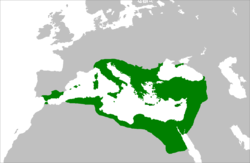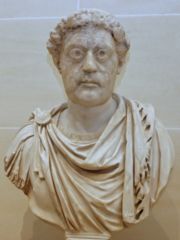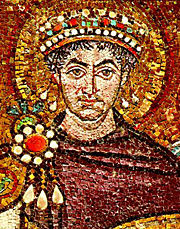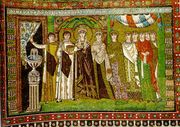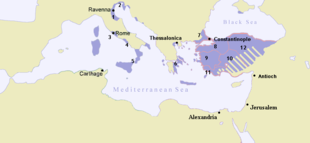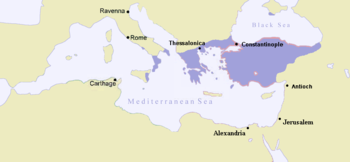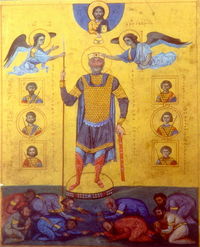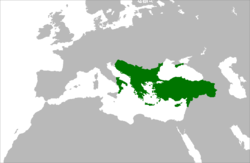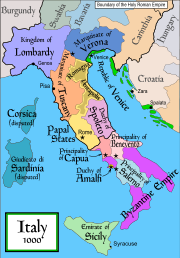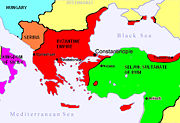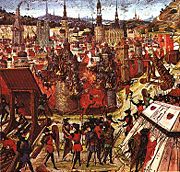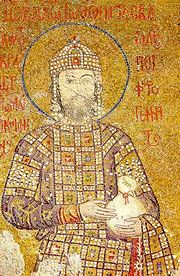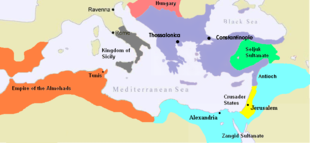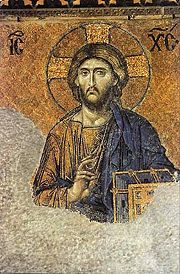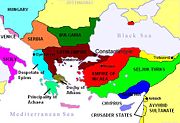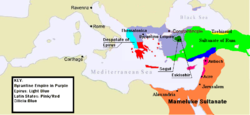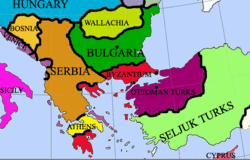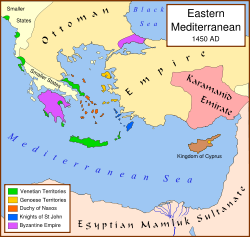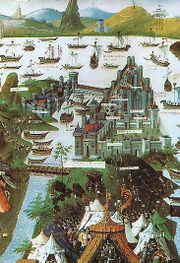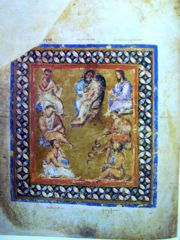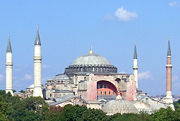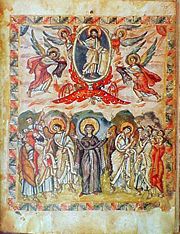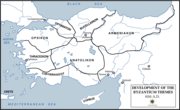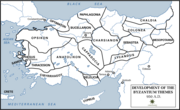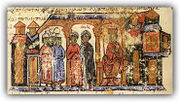Byzantine Empire
2008/9 Schools Wikipedia Selection. Related subjects: General history
|
|||||||||||||||||||||||||||||||||||||||||||||||||||||||||
The Byzantine Empire (a historiographical term used since the 19th century) and Eastern Roman Empire are expressions used to describe the Roman Empire of the Middle Ages, centered on its capital of Constantinople, referred to by its inhabitants simply as the Roman Empire (in Greek Βασιλεία Ῥωμαίων) or Romania (Ῥωμανία), its emperors continuing the unbroken succession of Roman emperors, preserving Greco-Roman legal and cultural traditions; to the Islamic world it was known primarily as روم ( Rûm, "land of the Romans"). Due to the dominance of Medieval Greek language, culture and population, it was known to many of its western European contemporaries as Empire of the Greeks.
As an outgrowth of the eastern portion of Empire founded in Rome, the Byzantine Empire's evolution into a separate culture from the West can be seen as a process beginning with Emperor Constantine's transferring the capital from Nicomedia in Anatolia to Byzantium on the Bosphorus (then renamed Nova Roma, and later Constantinople). By the 7th century under the reign of Emperor Heraclius, whose reforms changed the nature of the Empire's military and recognized Greek as the official language, the Empire had taken on a distinct new character.
During its existence the Empire suffered numerous setbacks and losses of territory but remained one of the most powerful economic, cultural and military forces in Europe. The empire's influence also spread into North Africa and the near East for much of the Middle Ages. After a final recovery under the Komnenian dynasty in the 12th century the Empire slipped into a long decline culminating in the capture of Constantinople and the remaining territories by the Ottoman Turks in the 15th century.
During her thousand-year reign, the Empire, a bastion of Christianity and one of the prime trade centers in the world, helped to shield Western Europe from early Muslim expansion, provided a stable gold currency for the Mediterranean region, influenced the laws, political systems, and customs of much of Europe and the Middle East, and preserved much of the literary works and scientific knowledge of ancient Greece, Rome, and many other cultures.
Etymology
| Byzantine Empire Timeline | |
|---|---|
| 667 BC | The ancient city of Byzantium (the future Constantinople and future Istanbul) is founded. |
| 27 BC | The rise of the Roman Empire. |
| ca. 235 - 284 | The " crisis of the 3rd century". |
| 292 | The reforms of Diocletian ("The Tetrarchy") |
| 330 | Constantine makes Byzantium into his capital (Nova Roma), which is renamed "Constantinople" (The City of Constantine), sometime after Constantine's death in 337. It would remain the capital of the Byzantine Empire, with a half-century exception, for over a thousand years. |
| 395 | The Empire is permanently split into eastern and western halves, following on the death of Theodosius I. |
| 527 | Justinian I is crowned " emperor". |
| April 7, 529 | The Codex Justinianus is promulgated. |
| 532– 537 |
The Emperor, Justinian, builds the church of Hagia Sophia |
| 533– 554 | Justinian's generals reconquer North Africa and Italy from the Vandals and the Ostrogoths. |
| 568 | The Lombard invasion results in the loss of most of Italy. |
| 634– 641 | The Arab armies conquer the Levant and Egypt. In the following decades, they take most of North Africa (and later conquer Sicily as well). |
| 697 | The Byzantine city of Carthage in North Africa (capital of the Exarchate of Africa) falls to the Arab invasion. |
| 730– 787 and 813– 843 | The Iconoclasm controversies result in the loss of most of the Empire's remaining Italian territories, aside from some of the territories of the Mezzogiorno. |
| 843– 1025 | The Macedonian dynasty is established and the Empire experiences a military and territorial revival. Byzantine scholars record and preserve many of the remaining ancient Greek and Roman texts. |
| 960– 1042 | The Byzantine Empire deals a string of defeats upon the forces of the Abassid and Fatimid Caliphate, reconquering parts of Mesopotamia, Syria and Palestine. |
| 1002– 1018 | The Emperor, Basil II, campaigns annually against the Bulgarians, with the object of annihilating the Bulgar state. |
| 1014 | The Bulgarian army is completely defeated at the Battle of Kleidon (Basil II becomes known as The Bulgar Slayer). |
| 1018 | Bulgaria surrenders and is annexed to the empire. The whole of the Balkans is incorporated into the Byzantine Empire, with the Danube as the new Imperial frontier to the north. |
| 1025 | With the death of Basil II, the zenith of the Empire's power is passed and the long decline of the Byzantine Empire begins. |
| 1054 | The Schism (split between Church in Rome and the Church in Constantinople). |
| 1071 | The Emperor, Romanos IV, is defeated by the Seljuk Turks at the Battle of Manzikert, losing his position in most of Asia Minor. In the same year, the last Byzantine outpost in Italy ( Bari) is conquered by the Normans. |
| 1081 | The Komnenos dynasty is established by Alexios I and Byzantium becomes involved in the Crusades. Economic prosperity generates new wealth; literature and the arts reach new heights. In Anatolia, the Turks become established. |
| 1091 | The Imperial armies defeat the Pechenegs at the Battle of Levounion. |
| 1097 | The recapture of Nicaea from the Turks by the Byzantine armies and the First Crusaders. |
| 1097- 1176 | The Byzantine armies recapture the coasts of Asia Minor from the Turks, and push east towards central Anatolia. The Crusader Principality of Antioch becomes a Byzantine protectorate. |
| 1122 | The Byzantines defeat the Pechenegs at the Battle of Beroia. |
| 1167 | The Byzantine armies win a decisive victory over the Hungarians at the Battle of Sirmium and Hungary subsequently becomes a Byzantine client state. |
| 1176 | Byzantine-Seljuk Wars: Manuel I Komnenos is defeated at the Battle of Myriokephalon; attempts to capture Konya, the capital of the Seljuk Turks are abandoned after the destruction of his siege equipment. Within a year Manuel recovers the situation status quo ante bellum. |
| 1180 | With the death of the Emperor, Manuel I Komnenos, the decline of the Empire recommences. |
| 1185 | A successful rebellion is organized in Bulgaria and other lands are lost in the Balkans. |
| 1204 | Constantinople is conquered by Crusaders, attempting to establish a Latin Empire. |
| 1261 | Constantinople is reconquered by the Patriarch of Constantinople sponsored Emperor of Nicaea, Michael VIII Palaiologos, re-establishing Greek rule of a terminally diminished empire. |
| 1326 | The city of Prusa in Asia Minor falls to the Ottoman Turks. |
| 1331 | The city of Nicaea, capital of the Empire only 100 years previously, falls to the Ottoman Turks. |
| 1453 | The Ottoman Turks conquer Constantinople, and with the death of Constantine XI Palaiologos, the last emperor of the Byzantine Empire, the Byzantine Empire comes to an end, marking final destruction of the Roman Empire. |
The term "Byzantine Empire" is an invention of historians and was never used during the Empire's lifetime. The Empire's name in Greek was Basileia Rhōmaiōn ( Greek: Βασιλεία Ῥωμαίων) — "The Empire of the Romans" — a translation of the Latin name of the Roman Empire (Latin: Imperium Romanōrum); or just Rhōmania ( Greek: Ῥωμανία).
The term "Byzantine" itself comes from " Byzantium", the name that the city of Constantinople had before it became the capital of Constantine. This older name of the city would rarely be used from this point onward except in historical or poetic contexts.
The designation of the Empire as "Byzantine" began in Western Europe in 1557, when German historian Hieronymus Wolf published his work Corpus Historiæ Byzantinæ, a collection of Byzantine sources. The publication in 1648 of the Byzantine du Louvre (Corpus Scriptorum Historiæ Byzantinæ), and in 1680 of Du Cange's Historia Byzantina further popularized the use of Byzantine among French authors, such as Montesquieu. It was not until the 19th century, however, with the birth of modern Greece, that the term "Byzantine" came into general use in the Western world.
Before this, the Empire was described by Western Europeans as Imperium Graecorum (Empire of the Greeks)—Byzantine claims to Roman inheritance had been actively contested from at least the time of the coronation of Charlemagne as Imperator Augustus by Pope Leo III in 800. Whenever the Popes or the rulers of the West wanted to make use of the name Roman to refer to the Byzantine emperors, they preferred the term Imperator Romaniæ instead of Imperator Romanorum, a title that Westerners maintained applied only to Charlemagne and his successors.
Origin
The Tetrarchy
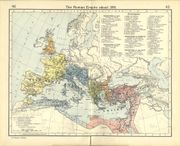
During the 3rd century, three crises threatened the Roman Empire: external invasions, internal civil wars and an economy riddled with weaknesses and problems. The city of Rome gradually became less important as an administrative centre. The crisis of the 3rd century displayed the defects of the heterogeneous system of government that Augustus had established to administer his immense dominion. His successors had introduced some modifications, but events made it clearer that a new, more centralised and more uniform system was required.
Diocletian was responsible for creating a new administrative system (the tetrarchy). He associated himself with a co-emperor, or Augustus. Each Augustus was then to adopt a young colleague, or Caesar, to share in the rule and eventually to succeed the senior partner. After the abdication of Diocletian and Maximian, however, the tetrachy collapsed, and Constantine I replaced it with the dynastic principle of hereditary succession.
Constantine I and his successors
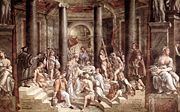
Constantine moved the seat of the Empire, and introduced important changes into its civil and religious constitution. In 330, he founded Constantinople as a second Rome on the site of Byzantium, which was well-positioned astride the trade routes between East and West; it was a superb base from which to guard the Danube river, and was reasonably close to the Eastern frontiers. Constantine also began the building of the great fortified walls, which were expanded and rebuilt in subsequent ages. J. B. Bury asserts that "the foundation of Constantinople [...] inaugurated a permanent division between the Eastern and Western, the Greek and the Latin, halves of the Empire—a division to which events had already pointed—and affected decisively the whole subsequent history of Europe."
Constantine built upon the administrative reforms introduced by Diocletian. He stabilized the coinage (the gold solidus that he introduced became a highly prized and stable currency), and made changes to the structure of the army. To divide administrative responsibilities, Constantine replaced the single praetorian prefect, who had traditionally exercised both military and civil functions, with regional prefects enjoying civil authority alone. In the course of the 4th century, four great sections emerged from these Constantinian beginnings, and the practice of separating civil from military authority persisted until the 7th century.
Under Constantine, Christianity did not become the exclusive religion of the state, but enjoyed imperial preference, since the Emperor supported it with generous privileges: clerics were exempted from personal services and taxation, Christians were preferred for administrative posts, and bishops were entrusted with judicial responsibilities. Constantine established the principle that emperors should not settle questions of doctrine, but should summon general ecclesiastical councils for that purpose. The Synod of Arles was convened by Constantine, and the First Council of Nicaea showcased his claim to be head of the Church.
The state of the Empire in 395 may be described in terms of the outcome of Constantine's work. The dynastic principle was established so firmly that the emperor who died in that year, Theodosius I, could bequeath the imperial office jointly to his sons: Arcadius in the East and Honorius in the West. Theodosius was the last emperor to rule over the full extent of the empire in both its halves.
Early history
The Eastern Empire was largely spared the difficulties faced by the West in the third and fourth centuries, due in part to a more firmly established urban culture and greater financial resources, which allowed it to placate invaders with tribute and pay barbarian mercenaries. Throughout the fifth century, various invading armies overran the Western Empire but spared the east. Theodosius II further fortified the walls of Constantinople, leaving the city impenetrable to attacks; they were not breached until 1204. To fend off the Huns of Attila, Theodosius gave them subsidies (purportedly 300 kg (700 lb) of gold). Moreover, he favored merchants living in Constantinople who traded with the barbarians.
His successor, Marcian, refused to continue to pay this exorbitant sum. However, Attila had already diverted his attention to the Western Roman Empire. After he died in 453, his empire collapsed and Constantinople initiated a profitable relationship with the remaining Huns, who would eventually fight as mercenaries in Byzantine armies.
After the fall of Attila, the true chief in Constantinople was the Alan general Aspar. Leo I managed to free himself from the influence of the barbarian chief by supporting the rise of the Isaurians, a semi- barbarian tribe living in southern Anatolia. Aspar and his son Ardabur were murdered in a riot in 471, and henceforth, Constantinople was freed from the influence of barbarian leaders for centuries.
Leo was also the first emperor to receive the crown not from a military leader, as was the Roman tradition, but from the Patriarch of Constantinople, representing the ecclesiastical hierarchy. This change became permanent, and in the Middle Ages the religious characteristic of the coronation completely supplanted the old military form. In 468, Leo unsuccessfully attempted to reconquer North Africa from the Vandals. By that time, the Western Roman Empire was restricted to Italy and the lands south of the Danube as far as the Balkans (the Angles and Saxons had invaded Britain as early as 410; the Visigoths and Suebi had possessed portions of Spania since 417, and the Vandals had entered Africa in 429; Gaul was contested by the Franks under Clovis I, Burgundians, Bretons, Visigoths and some Roman remnants; and Theodoric was destined to rule in Italy until 526).
In 466, as a condition of his Isaurian alliance, Leo married his daughter Ariadne to the Isaurian Tarasicodissa, who took the name Zeno. When Leo died in 474, Zeno and Ariadne's younger son succeeded to the throne as Leo II, with Zeno as regent. When Leo II died later that year, Zeno became emperor. The end of the Western Empire is sometimes dated to 476, early in Zeno's reign, when the barbarian general Odoacer deposed the titular Western Emperor Romulus Augustus, but declined to replace him with another puppet.
To recover Italy, Zeno could only negotiate with the Ostrogoths of Theodoric, who had settled in Moesia. He sent the barbarian king to Italy as magister militum per Italiam ("commander in chief for Italy"). After the fall of Odoacer in 493, Theodoric, who had lived in Constantinople during his youth, ruled Italy on his own. Thus, by suggesting that Theodoric conquer Italy as his Ostrogothic kingdom, Zeno maintained at least a nominal supremacy in that western land while ridding the Eastern Empire of an unruly subordinate.
In 475, Zeno was deposed by Basiliscus, the general who led Leo I's 468 invasion of North Africa, but he recovered the throne twenty months later. However, he faced a new threat from another Isaurian, Leontius, who was also elected rival emperor. In 491 Anastasius I, an aged civil officer of Roman origin, became emperor , but it was not until 498 that the forces of the new emperor effectively took the measure of Isaurian resistance. Anastasius revealed himself to be an energetic reformer and an able administrator. He perfected Constantine I's coinage system by definitively setting the weight of the copper follis, the coin used in most everyday transactions. He also reformed the tax system, and permanently abolished the hated chrysargyron tax. The State Treasury contained the enormous sum of 320,000 pounds of gold when he died.
Justinian I and his successors
Justinian I, who assumed the throne in 527, oversaw a period of Byzantine expansion into former Roman territories. Justinian, the son of an Illyrian peasant, may already have exerted effective control during the reign of his uncle, Justin I (518–527). In 532, attempting to secure his eastern frontier, Justinian signed a peace treaty with Khosrau I of Persia agreeing to pay a large annual tribute to the Sassinids. In the same year, Justinian survived a revolt in Constantinople (the Nika riots) which ended with the death of (allegedly) thirty thousand rioters. This victory solidified Justinian's power. Pope Agapetus I was sent to Constantinople by the Ostrogoths king Theodahad, but failed in his mission to sign a peace with Justinian. However, he succeeded in having the Monophysite Patriarch Anthimus I of Constantinople denounced, despite Empress Theodora's support. The western conquests began in 533, as Justinian sent his general Belisarius to reclaim the former province of North Africa from the Vandals with a small army of about 15,000 men. Success came with surprising ease, but it was not until 548 that the major local independent tribes were subdued. In Ostrogothic Italy, the deaths of Theodoric the Great, his nephew and heir Athalaric, and his daughter Amalasuntha had left her murderer Theodahad on the throne despite his weakened authority. In 535, a small Byzantine expedition sent to Sicily met with easy success, but the Goths soon stiffened their resistance, and victory did not come until 540, when Belisarius captured Ravenna, after successful sieges of Naples and Rome.
Nevertheless, the Ostrogoths were soon reunited under the command of Totila and captured Rome on December 17, 546; Belisarius was eventually recalled by Justinian in early 549. The arrival of the Armenian eunuch Narses in Italy (late 551) with an army of some 35,000 men marked another shift in Gothic fortunes. Totila was defeated and died at the Battle of Busta Gallorum. His successor, Teias, was likewise defeated at the Battle of Mons Lactarius (October 552). Despite continuing resistance from a few Goth garrisons and two subsequent invasions by the Franks and Alamanni, the war for the Italian peninsula was at an end. In 551, a noble of Visigothic Hispania, Athanagild, sought Justinian's help in a rebellion against the king, and the emperor dispatched a force under Liberius, who, although elderly, proved himself a successful military commander. The Byzantine empire held on to a small slice of the Spania coast until the reign of Heraclius.
In the east, Roman-Persian Wars continued until 561 when Justinian's and Khusro's envoys agreed on a 50-year peace. By the mid-550s, Justinian had won victories in most theatres of operation, with the notable exception of the Balkans, which were subjected to repeated incursions from the Slavs. In 559, the Empire faced a great invasion of Kutrigurs and Sclaveni. Justinian called Belisarius out of retirement, but once the immediate danger was over, the emperor took charge himself. The news that Justinian was reinforcing his Danube fleet made the Kutrigurs anxious, and they agreed to a treaty which gave them a subsidy and safe passage back across the river.
Justinian became universally famous because of his legislative work, remarkable for its sweeping character. In 529 a ten-man commission chaired by John the Cappadocian revised the ancient Roman legal code, creating the new Corpus Juris Civilis, a collection of laws that came to be referred to as "Justinian's Code". In the Pandects, completed under Tribonian's direction in 533, order and system were found in the contradictory rulings of the great Roman jurists, and a textbook, the Institutiones, was issued to facilitate instruction in the law schools. The fourth book, the Novellae, consisted of collections of imperial edicts promulgated between 534 and 565. Because of his ecclesiastical policies, Justinian came into collision with the Jews, the pagans, and various Christian sects. The latter included the Manichaeans, the Nestorians, the Monophysites, and the Arians. In order to completely eradicate paganism, Justinian closed the famous philosophic school in Athens in 529.
During the 6th century, the traditional Greco-Roman culture was still influential in the Eastern empire with prominent representatives such as the natural philosopher John Philoponus. Nevertheless, the Christian philosophy and culture were in the ascendant and began to dominate the older culture. Hymns written by Romanos the Melode marked the development of the Divine Liturgy, while architects and builders worked to complete the new Church of the Holy Wisdom, Hagia Sophia, designed to replace an older church destroyed in the course of the Nika revolt. Hagia Sophia stands today as one of the major monuments of architectural history. During the 6th and 7th centuries the Empire was struck by a series of epidemics, which would greatly devastate the population, contributing to a significant economic decline and weakening of the Empire.
Justinian's successor, Justin II, refused to pay the large tribute to the Persians. Meanwhile, the Germanic Lombards invaded Italy; by the end of the century only a third of Italy was in Byzantine hands. Justin's successor, Tiberius II, choosing between his enemies, awarded subsidies to the Avars while taking military action against the Persians. Although Tiberius' general, Maurice, led an effective campaign on the eastern frontier, subsidies failed to restrain the Avars. They captured the Balkan fortress of Sirmium in 582, while the Turks began to make inroads across the Danube. Maurice, who in the meantime had become emperor, made peace with the Sassanian Emperor Khosrau II, achieving access to Armenia, and forced the Avars and Slavs back across the Danube by 602.
Heraclian dynasty and shrinking borders
After Maurice's murder by Phocas, Khosrau used the pretext to reconquer the Roman province of Mesopotamia. Phocas, an unpopular ruler who is invariably described in Byzantine sources as a "tyrant", was the target of a number of senate-led plots. He was eventually deposed in 610 by Heraclius, who sailed to Constantinople from Carthage with an icon affixed to the prow of his ship. Following the accession of Heraclius the Sassanid advance pushed deep into Asia Minor, also occupying Damascus and Jerusalem and removing the True Cross to Ctesiphon. The counter-offensive of Heraclius took on the character of a holy war, and an acheiropoietos image of Christ was carried as a military standard. Similarly, when Constantinople was saved from an Avar siege in 626, the victory was attributed to the icons of the Virgin which were led in procession by Patriarch Sergius about the walls of the city. The main Sassanid force was destroyed at Nineveh in 627, and in 629 Heraclius restored the True Cross to Jerusalem in a majestic ceremony. The war had exhausted both the Byzantine and Sassanid Empire, and left them extremely vulnerable to the Arab forces which emerged in the following years. The Byzantines suffered a crushing defeat at the Battle of Yarmuk in 636, and Ctesiphon fell in 634.
Heraclius was the first emperor to replace the traditional Latin title for his office (Augustus) with the Greek Basileus (Βασιλεύς). This shift from Latin to Greek finds a parallel in the contemporary abandonment of Latin in official documents. In an attempt to heal the doctrinal divide between Chalcedonian and monophysite Christians, Heraclius proposed monotheletism as a compromise. In 638 the new doctrine was posted in the narthex of Hagia Sophia as part of a text called the Ekthesis, which also forbade further discussion of the issue. By this time, however, Syria and Palestine, both hotbeds of monophysite belief, had fallen to the Arabs, and another monophysite centre, Egypt, fell by 642. Ambivalence toward Byzantine rule on the part of monophysites may have lessened local resistance to the Arab expansion.
Heraclius did succeed in establishing a dynasty, and his descendants held onto the throne, with some interruption, until 711. Their reigns were marked both by major external threats, from the west and the east, which reduced the territory of the empire to a fraction of its 6th-century extent, and by significant internal turmoil and cultural transformation.
The Arabs, now firmly in control of Syria and the Levant, sent frequent raiding parties deep into Anatolia, and between 674 and 678 laid siege to Constantinople itself. The Arab fleet was finally repulsed through the use of Greek fire, and a thirty-years' truce was signed between the empire and caliphate. The Anatolian raids continued unabated, and accelerated the demise of classical urban culture, with the inhabitants of many cities either refortifying much smaller areas within the old city walls, or relocating entirely to nearby fortresses. The void left by the disappearance of the old semi-autonomous civic institutions was filled by the theme system, which entailed the division of Anatolia into "provinces" occupied by distinct armies which assumed civil authority and answered directly to the imperial administration. This system may have had its roots in certain ad hoc measures taken by Heraclius, but over the course of the seventh century it developed into an entirely new system of imperial governance.

The withdrawal of massive amounts of troops from the Balkans to combat the Persians and then the Arabs in the east opened the door for the gradual southward expansion of Slavic peoples into the peninsula, and, as in Anatolia, many cities shrank to small fortified settlements. In the 670s the Bulgars were pushed south of the Danube by the arrival of the Khazars, and in 680 Byzantine forces which had been sent to disperse these new settlements were defeated. In the next year Constantine IV signed a treaty with the Bulgar khan Asparukh, and the new Bulgarian state assumed sovereignty over a number of Slavic tribes which had previously, at least in name, recognized Byzantine rule. In 687/8, emperor Justinian II led an expedition against the Slavs and Bulgars which made significant gains, although the fact that he had to fight his way from Thrace to Macedonia demonstrates the degree to which Byzantine power in the north Balkans had declined.
The one Byzantine city that remained relatively unaffected, despite a significant drop in population and at least two outbreaks of the plague, was Constantinople. However, the imperial capital was marked by its own variety of conflict, both political and religious. Constans II continued the monothelete policy of his grandfather, Heraclius, meeting with significant opposition from laity and clergy alike. The most vocal opponents, Maximus the Confessor and Pope Martin I were arrested, brought to Constantinople, tried, tortured, and exiled. Constans seems to have become immensely unpopular in the capital, and moved his residence to Syracuse, Sicily, where he was ultimately murdered by a member of his court. The Senate experienced a revival in importance in the seventh century and clashed with the emperors on numerous occasions. The final Heraclian emperor, Justinian II, attempted to break the power of the urban aristocracy through severe taxation and the appointment of "outsiders" to administrative posts. He was driven from power in 695, and took shelter first with the Khazars and then with the Bulgars. In 705 he returned to Constantinople with the armies of the Bulgar khan Tervel, retook the throne, and instituted a reign of terror against his enemies. With his final overthrow in 711, supported once more by the urban aristocracy, the Heraclian dynasty came to an end.
The 7th century was a period of radical transformation. The empire which had once stretched from Spain to Jerusalem was now reduced to Anatolia, Chersonesos, and some fragments of Italy and the Balkans. The territorial losses were accompanied by a cultural shift; urban civilization was massively disrupted, classical literary genres were abandoned in favour of theological treatises, and a new "radically abstract" style emerged in the visual arts. That the empire survived this period at all is somewhat surprising, especially given the total collapse of the Sassanid Empire in the face of the Arab expansion, but a remarkably coherent military reorganization helped to withstand the exterior pressures and laid the groundwork for the gains of the following dynasty.
Isaurian dynasty and Iconoclasm
Leo III the Isaurian turned back the Muslim assault in 718, and achieved a major victory at the expense of the Arabs in 740. He also addressed himself to the task of reorganizing and consolidating the themes in Asia Minor. His successor, Constantine V, won noteworthy victories in northern Syria, and thoroughly undermined Bulgar strength. In the beginning of the 9th century the Arabs captured Crete, and successfully attacked Sicily, but on September 3, 863, general Petronas attained a huge victory against the emir of Melitene. Under the leadership of Krum the Bulgar threat also reemerged, but in 814 Krum's son, Omortag, arranged a peace with the Byzantine Empire.
The 8th and 9th centuries were also dominated by controversy and religious division over Iconoclasm. Icons were banned by Leo and Constantine, leading to revolts by iconodules (supporters of icons) throughout the empire. After the efforts of Empress Irene, the Second Council of Nicaea met in 787, and affirmed that icons could be venerated but not worshipped. Irene is said to have endeavored to negotiate a marriage between herself and Charlemagne, but, according to Theophanes the Confessor, the scheme was frustrated by Aetios, one of her favourites. In 813 Leo V the Armenian restored the policy of iconoclasm, but in 843 Empress Theodora restored the veneration of the icons with the help of Patriarch Methodios. Iconoclasm played its part in the further alienation of East from West, which worsened during the so-called Photian Schism, when Pope Nicholas I challenged Photios' elevation to the patriarchate.
Macedonian dynasty and resurgence
The Byzantine Empire reached its height under the Macedonian emperors (of Armenian and Greek descent) of the late 9th, 10th, and early 11th centuries, when it gained control over the Adriatic Sea, southern Italy, and all of the territory of tsar Samuil of Bulgaria. The cities of the empire expanded, and affluence spread across the provinces because of the new-found security. The population rose, and production increased, stimulating new demand while also helping to encourage trade. Culturally, there was considerable growth in education and learning. Ancient texts were preserved and patiently re-copied. Byzantine art flourished, and brilliant mosaics graced the interiors of the many new churches. Though the empire was significantly smaller than during the reign of Justinian, it was also stronger, as the remaining territories were less geographically dispersed and more politically and culturally integrated.
Internal developments
Although traditionally attributed to Basil I (867–886), initiator of the Macedonian dynasty, the " Byzantine renaissance" has been more recently ascribed to the reforms of his predecessor, Michael III (842–867) and his wife's counsellor, the erudite Theoktistos. The latter in particular favoured culture at the court, and, with a careful financial policy, steadily increased the gold reserves of the Empire. The rise of the Macedonian dynasty coincided with internal developments which strengthened the religious unity of the empire. The iconoclast movement was experiencing a steep decline: this favoured its soft suppression by the emperors and the reconciliation of the religious strife that had drained the imperial resources in the previous centuries. Despite occasional tactical defeats, the administrative, legislative, cultural and economic situation continued to improve under Basil's successors, especially with Romanos I Lekapenos (920–944). The theme system reached its definitive form in this period. The church establishment began to loyally support the imperial cause, and the power of the landowning class was limited in favour of agricultural small holders, who made up an important part of the military force of the Empire. These favourable conditions contributed to the increasing ability of the emperors to wage war against the Arabs.
Wars against the Muslims
By 867, the empire had stabilised its position in both the east and the west, while the success of its defensive military structure had enabled the emperors to begin planning wars of reconquest in the east.
The process of reconquest began with variable fortunes. The temporary reconquest of Crete (843) was followed by a crushing Byzantine defeat on the Bosporus, while the emperors were unable to prevent the ongoing Muslim conquest of Sicily (827–902). Using present day Tunisia as their launching pad, the Muslims conquered Palermo in 831, Messina in 842, Enna in 859, Syracuse in 878, Catania in 900 and the final Greek stronghold, the fortress of Taormina, in 902.
These drawbacks were later counterbalanced by a victorious expedition against Damietta in Egypt (856), the defeat of the Emir of Melitene (863), the confirmation of the imperial authority over Dalmatia (867) and Basil I's offensives towards the Euphrates (870s).
The threat from the Muslims was meanwhile reduced by inner struggles and by the rise of the Turks in the east. Muslims received assistance however from the Paulician sect, which had found a large following in the eastern provinces of the Empire and, facing persecution under the Byzantines, often fought under the Arab flag. It took several campaigns to subdue the Paulicians, who were eventually defeated by Basil I.
In 904, disaster struck the empire when its second city, Thessaloniki, was sacked by an Arab fleet led by a Byzantine renegade. The Byzantines responded by destroying an Arab fleet in 908, and sacking the city of Laodicea in Syria two years later. Despite this revenge, the Byzantines were still unable to strike a decisive blow against the Muslims, who inflicted a crushing defeat on the imperial forces when they attempted to regain Crete in 911.
The situation on the border with the Arab territories remained fluid, with the Byzantines alternatively on the offensive or defensive. The Varangians, who attacked Constantinople for the first time in 860, constituted another new challenge. In 941 they appeared on the Asian shore of the Bosporus, but this time they were crushed, showing the improvements in the Byzantine military position after 907, when only diplomacy had been able to push back the invaders. The vanquisher of the Varangians was the famous general John Kourkouas, who continued the offensive with other noteworthy victories in Mesopotamia (943): these culminated in the reconquest of Edessa (944), which was especially celebrated for the return to Constantinople of the venerated Mandylion.
The soldier emperors Nikephoros II Phokas (reigned 963–969) and John I Tzimiskes (969–976) expanded the empire well into Syria, defeating the emirs of north-west Iraq and reconquering Crete and Cyprus. At one point under John, the empire's armies even threatened Jerusalem, far to the south. The emirate of Aleppo and its neighbours became vassals of the empire in the east, where the greatest threat to the empire was the Egyptian Fatimid kingdom.
Wars against the Bulgarians
The traditional struggle with the See of Rome continued, spurred by the question of religious supremacy over the newly Christianized Bulgaria. This prompted an invasion by the powerful Tsar Simeon I in 894, but this was pushed back by the Byzantine diplomacy, which called on the help of the Hungarians. The Byzantines were in turn defeated, however, at the Battle of Bulgarophygon (896), and obliged to pay annual subsides to the Bulgarians. Later (912) Simeon even had the Byzantines grant him the crown of basileus of Bulgaria and had the young emperor Constantine VII marry one of his daughters. When a revolt in Constantinople halted his dynastic project, he again invaded Thrace and conquered Adrianople.
A great imperial expedition under Leo Phocas and Romanos Lekapenos ended again with a crushing Byzantine defeat at the Battle of Anchialus (917), and the following year the Bulgarians were free to ravage northern Greece up to Corinth. Adrianople was captured again in 923 and in 924 a Bulgarian army laid siege to Constantinople. The situation in the Balkans improved only after Simeon's death in 927.
Under the emperor Basil II (reigned 976–1025), the Bulgarians, who had conquered much of the Balkans from the Byzantines since their arrival three hundred years previously, became the target of annual campaigns by the Byzantine army. The war was to drag on for nearly twenty years, but eventually at the Battle of Kleidon the Bulgarians were completely defeated. The Bulgarian army was captured, and it is said that 99 out of every 100 men were blinded, with the remaining hundredth man left with one eye so as to lead his compatriots home. When Tsar Samuil saw the broken remains of his once gallant army, he died of shock. In 1018 Bulgaria surrendered and became part of the empire. This stunning victory restored the Danube frontier, which had not been held since the days of the emperor Heraclius.
The empire also gained a new ally at this time in the new Varangian state in Kiev, from which the empire received an important mercenary force, the famous Varangian Guard, in exchange for the marriage of Basil's sister Anna to Vladimir I of Kiev. During this period the Byzantine princess Theophanu, wife of the Holy Roman Emperor Otto II, served as regent of the Holy Roman Empire, paving the way for the westward spread of Byzantine culture.
Triumph
The Byzantine Empire now stretched to Armenia in the east, to Calabria in Southern Italy in the west. Many successes had been achieved, ranging from the conquest of Bulgaria, to the annexation of parts of Georgia and Armenia, to the total annihilation of an invading force of Egyptians outside Antioch. Yet even these victories were not enough; Basil considered the continued Arab occupation of Sicily to be an outrage. Accordingly, he planned to reconquer the island, which had belonged to the empire for over 300 years (c. 550 – c. 900). However, his death in 1025 put an end to the project.
The 11th century was also momentous for its religious events. In 1054, relations between Greek-speaking Eastern and Latin-speaking Western traditions within the Christian Church reached a terminal crisis. Although there was a formal declaration of institutional separation, on July 16, when three papal legates entered the Hagia Sophia during Divine Liturgy on a Saturday afternoon and placed a bull of excommunication on the altar, the so-called Great Schism was actually the culmination of centuries of gradual separation. Although the schism was brought about by doctrinal disputes (in particular, Eastern refusal to accept the Western Church doctrine of the filioque, or double procession of the Holy Spirit), disputes over administration and political issues had simmered for centuries. The formal separation of the Byzantine Orthodox Church and the Western Catholic Church would have wide ranging consequences for the future of Byzantium.
Crisis and fragmentation
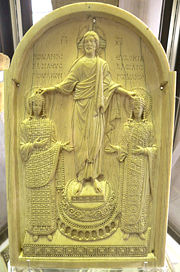
Byzantium soon fell into a period of difficulties, caused to a large extent by the undermining of the theme system and the neglect of the military. Nikephoros II, John Tzimiskes and Basil II changed the military divisions (τάγματα, tagmata) from a rapid response, primarily defensive, citizen army into a professional, campaigning army increasingly manned by mercenaries. Mercenaries, however, were expensive and as the threat of invasion receded in the 10th century, so did the need for maintaining large garrisons and expensive fortifications. Basil II left a burgeoning treasury upon his death, but neglected to plan for his succession. None of his immediate successors had any particular military or political talent and the administration of the Empire increasingly fell into the hands of the civil service. Efforts to revive the Byzantine economy only resulted in inflation and a debased gold coinage. The army was now seen as both an unnecessary expense and a political threat. Therefore, native troops were cashiered and replaced by foreign mercenaries on specific contract.
At the same time, the Empire was faced with new, ambitious enemies. Byzantine provinces in southern Italy faced the Normans, who arrived in Italy at the beginning of the 11th century. The allied forces of Melus of Bari and the Normans were defeated at the Battle of Cannae in 1018, and two decades later Michael IV the Paphlagonian equipped an expedition for the reconquest of Sicily from the Arabs. Although the campaign was initially successful, the reconquest of Sicily was not accomplished, mainly because George Maniaces, the commander of the Byzantine forces, was recalled when he was suspected of having ambitious schemes. During a period of strife between Byzantium and Rome which ended in the East-West Schism of 1054, the Normans began to advance, slowly but steadily, into Byzantine Italy.
It was in Asia Minor, however, that the greatest disaster would take place. The Seljuq Turks made their first explorations across the Byzantine frontier into Armenia in 1065 and in 1067. The emergency lent weight to the military aristocracy in Anatolia who, in 1068, secured the election of one of their own, Romanos Diogenes, as emperor. In the summer of 1071, Romanos undertook a massive eastern campaign to draw the Seljuks into a general engagement with the Byzantine army. At Manzikert Romanos not only suffered a surprise defeat at the hands of Sultan Alp Arslan, but was also captured. Alp Arslan treated him with respect, and imposed no harsh terms on the Byzantines. In Constantinople, however, a coup took place in favour of Michael Doukas, who soon faced the opposition of Nikephoros Bryennios and Nikephoros Botaneiates. By 1081 the Seljuks expanded their rule over virtually the entire Anatolian plateau from Armenia in the east to Bithynia in the west and founded their capital in Nicea.
Komnenian dynasty and the crusaders
Alexios I and the First Crusade
After Manzikert, a partial recovery (referred to as the Komnenian restoration) was made possible by the efforts of the Komnenian dynasty. The first emperor of this royal line was Isaac I (1057–1059) and the second Alexios I. At the very outset of his reign, Alexios faced a formidable attack by the Normans under Robert Guiscard and his son Bohemund of Taranto, who captured Dyrrhachium and Corfu, and laid siege to Larissa in Thessaly. Robert Guiscard's death in 1085 temporarily eased the Norman problem. The following year the Seljuq sultan died, and the sultanate was split by internal rivalries. By his own efforts, Alexios defeated the Pechenegs; they were caught by surprise and annihilated at the Battle of Levounion on 28 April 1091.
Having achieved stability in the West, Alexios could turn his attention to the severe economic difficulties and the disintegration of the empire's traditional defences. However, he still did not have enough manpower to recover the lost territories in Asia Minor, and to advance against the Seljuks. At the Council of Piacenza in 1095, Alexios' envoys spoke to Pope Urban II about the suffering of the Christians of the East, and underscored that without help from the West they would continue to suffer under Muslim rule. Urban saw Alexius' request as a dual opportunity to cement Western Europe and enhance papal power. On 27 November 1095, Pope Urban II called together the Council of Clermont, and urged all those present to take up arms under the sign of the Cross and launch an armed pilgrimage to recover Jerusalem and the East from the Muslims. The response in Western Europe was overwhelming.
Alexios had anticipated help in the form of mercenary forces from the West, but was totally unprepared for the immense and undisciplined force which soon arrived in Byzantine territory. It was no comfort to Alexius to learn that four of the eight leaders of the main body of the Crusade were Normans, among them Bohemund. Since the crusade had to pass through Constantinople, however, the Emperor had some control over it. He required its leaders to swear to restore to the empire any towns or territories they might conquer from the Turks on their way to the Holy Land. In return, he gave them guides and a military escort. Alexios was able to recover a number of important cities and islands, and in fact much of western Asia Minor. Nevertheless, the crusaders believed their oaths were invalidated when Alexios did not help them during the siege of Antioch (he had in fact set out on the road to Antioch, but had been persuaded to turn back by Stephen of Blois, who assured him that all was lost and that the expedition had already failed). Bohemund, who had set himself up as Prince of Antioch, briefly went to war with the Byzantines, but agreed to become Alexios' vassal under the Treaty of Devol in 1108, which marked the end of Norman threat during Alexios' reign.
Alexios reconstituted the army and navy, but only by means of stabilizing the gold coinage at one-third of its original value and by imposing supplementary taxes. The supply of native soldiers had virtually ceased with the disappearance or absorption of their military holdings. Alexios promoted an alternative source of native manpower by extending the system of granting estates in pronoia (by favour of the emperor) and tying the grant to a military obligation. Similarly, Alexios tried to promote more profitable development of the estates of the church by granting them to the management of laymen. The final years of Alexios's reign were marked by persecution of the followers of the Paulician and Bogomil heresies, and by anxieties as to the succession, which his wife Irene Doukaina wished to alter in favour of her daughter Anna's husband, Nikephoros Bryennios.
John II, Manuel I and the Second Crusade
Alexios' son John II Komnenos succeeded him in 1118, and was to rule until 1143. John was a pious and dedicated emperor who was determined to undo the damage his empire had suffered at the battle of Manzikert, half a century earlier. Famed for his piety and his remarkably mild and just reign, John was an exceptional example of a moral ruler, at a time when cruelty was the norm. For this reason, he has been called the Byzantine Marcus Aurelius. In the course of his twenty-five year reign, John made alliances with the Holy Roman Empire in the west, decisively defeated the Pechenegs at the Battle of Beroia, and personally led numerous campaigns against the Turks in Asia Minor. John's campaigns fundamentally changed the balance of power in the east, forcing the Turks onto the defensive and restoring to the Byzantines many towns, fortresses and cities right across the peninsula. He also thwarted Hungarian, and Serbian threats during the 1120s, and in 1130 allied himself with the German emperor Lothair III against the Norman King Roger II of Sicily. In the later part of his reign John focused his activities on the East. He defeated the Danishmend emirate of Melitene, and reconquered all of Cilicia, while forceing Raymond of Poitiers, Prince of Antioch, to recognize Byzantine suzerainty. In an effort to demonstrate the Byzantine emperor's role as the leader of the Christian world, John marched into the Holy Land at the head of the combined forces of Byzantium and the Crusader states; yet despite the great vigour with which he pressed the campaign, John's hopes were disappointed by the treachery of his Crusader allies. In 1142 John returned to press his claims to Antioch, but he died in the spring of 1143 following a hunting accident. Raymond was emboldened to invade Cilicia, but he was defeated and forced to go to Constantinople to beg mercy from the new emperor.
John's chosen heir was his fourth son, Manuel I Komnenos, who campaigned aggressively against his neighbours both in the west and in the east. In Palestine, he allied himself with the Crusader Kingdom of Jerusalem and sent a large fleet to participate in a combined invasion of Fatimid Egypt. Manuel reinforced his position as overlord of the Crusader states, with his hegemony over Antioch and Jerusalem secured by agreement with Raynald, Prince of Antioch, and Amalric, King of Jerusalem respectively. In an effort to restore Byzantine control over the ports of southern Italy, he sent an expedition to Italy in 1155, but disputes within the coalition led to the eventual failure of the campaign. Despite this military setback, Manuel's armies successfully invaded the Kingdom of Hungary in 1167, defeating the Hungarians at the Battle of Sirmium. By 1168 nearly the whole of the eastern Adriatic coast lay in Manuel's hands. Manuel made several alliances with the Pope and Western Christian kingdoms, and successfully handled the passage of the Second Crusade through his empire. Although hopes for a lasting Papal-Byzantine alliance came up against insuperable problems, Pope Innocent III clearly had a positive view of Manuel when he told Alexios III that he should imitate "your predecessor Manuel of famous memory" who "always replied favourably to ourselves and our predecessors".
In the east, however, Manuel suffered a major defeat at the Battle of Myriokephalon, in 1176, against the Turks. Yet the losses were quickly made good, and in the following year Manuel's forces inflicted a defeat upon a force of "picked Turks". John Vatatzes, who was sent by the Emperor to repel the Turkish invasion, not only brought troops from the capital but also was able to gather an army along the way; a sign that the Byzantine army remained strong and that the defensive program of western Asia Minor was still successful.
12th century Renaissance
John and Manuel pursued active military policies, and both deployed considerable resources on sieges and on city defenses; aggressive fortification policies were at the heart of their imperial military policies. Despite the defeat at Myriokephalon, the policies of Alexios, John and Manuel resulted in vast territorial gains, increased frontier stability in Asia Minor, and secured the stabilization of the empire's European frontiers. From c.1081 to c.1180, the Komnenian army assured the empire's security, enabling Byzantine civilization to flourish.
This allowed the Western provinces to achieve an economic revival which continued until the close of the century. It has been argued that Byzantium under the Komnenian rule was more prosperous than at any time since the Persian invasions of the 7th century. During the 12th century population levels rose and extensive tracts of new agricultural land were brought into production. Archaeological evidence from both Europe and Asia Minor shows a considerable increase in the size of urban settlements, together with a notable upsurge in new towns. Trade was also flourishing; the Venetians, the Genoese and others opened up the ports of the Aegean to commerce, shipping goods from the Crusader kingdoms of Outremer and Fatimid Egypt to the west and trading with the Byzantine Empire via Constantinople.
In artistic terms, there was a revival in mosaic, and regional schools of architecture began producing many distinctive styles that drew on a range of cultural influences. During the 12th century the Byzantines provided their model of early humanism as a renaissance of interest in classical authors. In Eustathius of Thessalonica Byzantine humanism found its most characteristic expression.
Decline and disintegration
Dynasty of the Angeloi and Third Crusade
| "Whatever paper might be presented to the Emperor (Alexios III) for his signature, he signed it immediately; it did not matter that in this paper there was a senseless agglomeration of words, or that the supplicant demanded that one might sail by land or till the sea, or that mountains should be transferred into the middle of the seas or, as a tale says, that Athos should be put upon Olympus." |
| Nicetas Choniates |
Manuel's death on 24 September 1180 left his 11-year-old son Alexios II Komnenos on the throne. Alexios was highly incompetent at the office, but it was his mother, Maria of Antioch, and her Frankish background that made his regency unpopular. Eventually Andronikos I Komnenos, a grandson of Alexios I, launched a revolt against his younger relative and managed to overthrow him in a violent coup d'état. Utilizing his good looks and his immense popularity with the army, he marched on to Constantinople in August 1182, and incited a massacre of the Latins. After eliminating his potential rivals, he had himself crowned as co-emperor in September 1183; he eliminated Alexios II and even took his 12-year-old wife Agnes of France for himself.
This troubled succession weakened the dynastic continuity and solidarity on which the strength of the Byzantine state had come to rely. The new emperor was a man of astounding contrasts. Handsome and eloquent, Andronikos was at the same time known for his licentious exploits. Energetic, able and determined, he had been called a "true Komnenos". However, he was also capable of terrifying brutality, violence and cruelty.
Andronikos began his reign well; in particular, the measures he took to reform the government of the empire have been praised by historians. According to George Ostrogorsky, Andronikos was determined to root out corruption: Under his rule the sale of offices ceased; selection was based on merit, rather than favoritism; officials were paid an adequate salary so as to reduce the temptation of bribery. In the provinces Andronikos' reforms produced a speedy and marked improvement. The people felt the severity of his laws, but acknowledged their justice, and found themselves protected from the rapacity of their superiors. Andronikos' efforts to rein in the oppressive tax collectors and officials of the empire did much to alleviate the lot of the peasantry, but his attempt to check the power of the nobility was considerably more problematic. The aristocrats were infuriated against him, and to make matters worse, Andronikos seems to have become increasingly unbalanced; executions and violence became increasingly common, and his reign turned into a reign of terror. Andronikos seemed almost to seek the extermination of the aristocracy as a whole. The struggle against the aristocracy turned into wholesale slaughter, while the emperor resorted to ever more ruthless measures to shore up his regime.
Despite his military background, Andronikos failed to deal with Isaac Komnenos, Béla III who reincorporated Croatian territories into Hungary, and Stephen Nemanja of Serbia who declared his independence from Byzantium. Yet none of these troubles would compare to William II of Sicily's invasion force of 300 ships and 80,000 men, arriving in 1185. Andronikos mobilized a small fleet of 100 ships to defend the capital but other than that he was indifferent to the populace. He was finally overthrown when Isaac Angelos, surviving an imperial assassination attempt, seized power with the aid of the people and had Andronikos killed.
The reign of Isaac II, and, still more, that of his brother Alexios III, saw the collapse of what remained of the centralized machinery of Byzantine government and defense. Although, the Normans were driven out of Greece, in 1186 the Bulgars began a rebellion that was to lead to the formation of the Second Bulgarian Empire. The mismanagement of the Third Crusade clearly demonstrated Byzantium's weaknesses under the Angeli. When Richard I of England appropriated Cyprus from its ruler, Isaac Komnenos, he refused to hand it back to the Empire, And when Frederick Barbarossa conquered Iconium, Isaac failed to seize the initiative. The internal policy of the Angeloi was characterized by the squandering of the public treasure, and the fiscal maladministration. Byzantine authority was severely weakened, and the growing power vacuum at the centre of the empire encouraged fragmentation. There is evidence that some Komnenian heirs had set up a semi-independent state in Trebizond before 1204. According to Alexander Vasiliev, "the dynasty of the Angeloi, Greek in its origin, [...] accelerated the ruin of the Empire, already weakened without and disunited within."
Fourth Crusade
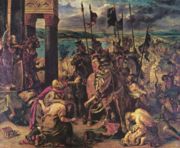
In 1198, Pope Innocent III broached the subject of a new crusade through legates and encyclical letters. The stated intent of the crusade was to conquer Egypt, now the centre of Muslim power in the Levant. The crusader army that arrived at Venice in the summer of 1202 was somewhat smaller than had been anticipated, and there were not sufficient funds to pay the Venetians, whose fleet was hired by the crusaders to take them to Egypt. Venetian policy under the aging and blind but still ambitious Doge Enrico Dandolo was potentially at variance with that of the Pope and the crusaders, because Venice was closely related commercially with Egypt. The crusaders accepted the suggestion that in lieu of payment they assist the Venetians in the capture of the (Christian) port of Zara in Dalmatia (vassal city of Venice, which had rebelled and placed itself under Hungary's protection in 1186). The city fell in November 1202 after a brief siege. Innocent, who was informed of the plan, but his veto was disregarded, was reluctant to jeopardize the Crusade, and gave conditional absolution to the crusaders—not, however, to the Venetians.
After the death of Theobald III, Count of Champagne, the leadership of the Crusade passed to Boniface of Montferrat, a friend of the Hohenstaufen Philip of Swabia. Both Boniface and Philip had married into the Byzantine imperial family. In fact, Philip's brother-in-law, Alexios Angelos, son of the deposed and blinded emperor Isaac II Angelos, had appeared in Europe seeking aid and had made contacts with the crusaders. Alexios offered to reunite the Byzantine church with Rome, pay the crusaders 200,000 silver marks, and join the crusade with 200,000 silver marks and all the supplies they needed to get to Egypt. Innocent was aware of a plan to divert the Crusade to Constantinople, and forbade any attack on the city; but the papal letter arrived after the fleets had left Zara.
Alexios III made no preparations for the defense of the city; thus, when the Venetian fleet entered the waters of Constantinople on June 24, 1203, they encountered little resistance. In the summer of 1203 Alexios III fled, and Alexios Angelos was elevated to the throne as Alexios IV along with his blind father Isaac. Innocent reprimanded the leaders of the crusaders, and ordered them to proceed forthwith to the Holy Land.
| "None of you should therefore dare to assume that it is permissible for you to seize or to plunder the land of the Greeks, even though the latter may be disobedient to the Apostolic See, or on the grounds that the Emperor of Constantinople has deposed and even blinded his brother and usurped the imperial throne. For though this same emperor and the men entrusted to his rule may have sinned, both in these and in other matters, it is not for you to judge their faults, nor have you assumed the sign of the cross to punish this injury; rather you specifically pledged your self to the duty of avenging the insult to the cross." |
| Innocent III to Boniface I of Montferrat, Baldwin IX, Count of Flanders, and Louis I, Count of Blois ( Ferentino, summer 1203, c. June 20). |
When in late November 1203 Alexios IV announced that his promises were hard to keep as the empire was short on funds (he had managed to pay roughly half of the promised amount of 200,000 silver marks, and could not fulfil his promise that he would cover the Venetians' rent of the fleet for the crusaders.), the crusaders declared war on him. Meanwhile, internal opposition to Alexios IV grew, and, on January 25, 1204, one of his courtiers, Alexios Doukas killed him, and took the throne himself as Alexios V; Isaac died soon afterwards, probably naturally. The crusaders and Venetians, incensed at the murder of their supposed patron, prepared to assault the Byzantine capital. They decided that 12 electors (six Venetians and six crusaders) should choose a Latin emperor.
Eventually, the crusaders took the city on April 13, 1204. Constantinople was subjected by the rank and file to pillage and massacre for three days. Many priceless icons, relics, and other objects later turned up in Western Europe, a large number in Venice. According to Choniates, a prostitute was even set up on the Patriarchal throne. When Innocent III heard of the conduct of his crusaders, he castigated them in no uncertain terms. But the situation was beyond his control, especially after his legate, on his own initiative, had absolved the crusaders from their vow to proceed to the Holy Land. When order had been restored, the crusaders and the Venetians proceeded to implement their agreement; Baldwin of Flanders was elected emperor and the Venetian Thomas Morosini chosen patriarch. The lands parcelled out among the leaders did not include all the former Byzantine possessions. The Byzantine rule continued in Nicaea, Trebizond, and Epirus. (Capital cities of the latter, Nicaea,Trebizond, Ioannina).
Fall
Empire in exile
After the sack of Constantinople in 1204 by Latin Crusaders, three Byzantine successor states were established: the Empire of Nicaea, the Empire of Trebizond and the Despotate of Epirus. Of these three successor states, Epirus and Nicaea stood the best chance of reclaiming Constantinople. The Nicaean Empire struggled, however, to survive the next few decades, and by the mid 13th century it lost much of southern Anatolia. The weakening of the Sultanate of Rum following the Mongol Invasion in 1242-43 allowed many Beyliks and fanatical ghazis to set up their own principalities in Anatolia, weakening the Byzantine hold on Asia Minor. In time, one of the Beys, Osman I, created an empire that would conquer Byzantium. However, the Mongol Invasion also gave Nicaea a temporary respite from Seljuk attacks allowing it to concentrate on the Latin Empire only north of its position.
Reconquest of Constantinople
The Empire of Nicaea, founded by the Laskaris, managed to reclaim Constantinople from the Latins in 1261 and defeat Epirus. This led to a short lived revival of Byzantine fortunes under Michael VIII, but the war-ravaged empire was ill-equipped to deal with the enemies that now surrounded it. In order to maintain his campaigns against the Latins, Michael pulled troops from Asia Minor, and levied crippling taxes on the peasantry, causing much resentment. Massive construction projects were completed in Constantinople to repair the damages of the Fourth Crusade, but none of these initiatives was of any comfort to the farmers in Asia Minor, suffering raids from fanatical ghazis.
Rather than holding on to his possessions in Asia Minor, Michael chose to expand the Empire, gaining only short-term success. To avoid another sacking of the capital by the Latins, he forced the Church to submit to Rome, again a temporary solution for which the peasantry hated Michael and Constantinople. The efforts of Andronikos II and later his grandson Andronikos III marked Byzantium's last genuine attempts in restoring the glory of the empire. However, the use of mercenaries by Andronikos II would often backfire, with the Catalan Company ravaging the countryside and increasing resentment towards Constantinople By 1390, Philadelphia, the last Byzantine stronghold in inner Asia Minor, fell to the Turks.
Civil war wrecked the empire during the 14th century, since Andronikos III's successor was far too young to rule and the resulting regency's rivalry tore the Empire. The Asian provinces were lost to the Turks, while the Serbians and Bulgarians conquered the Empire's remaining territory in Europe. For a while, the empire survived simply because the Turks of Anatolia were too divided to attack. Nevertheless, the unifying influence of Osman I (1258–1326) allowed the newly founded Ottoman Empire to deprive the Byzantines of all but a handful of port cities.
Things went worse for Byzantium, when, during the civil war, an earthquake at Gallipoli in 1354 devastated the fort, allowing the Turks the very next day to cross into Europe. By the time the Byzantine civil war had ended, the Ottomans had defeated the Serbians and subjugated them as vassals. Following the Battle of Kosovo, much of the Balkans became dominated by the Ottomans.
The Emperors appealed to the west for help, but the Pope would only consider sending aid in return for a reunion of the Eastern Orthodox Church with the See of Rome. Church unity was considered, and occasionally accomplished by imperial decree, but the Orthodox citizenry and clergy intensely resented Roman authority and the Latin Rite. Some western mercenaries arrived to bolster the Christian defence of Constantinople, but most Western rulers, distracted by their own affairs, did nothing as the Ottomans picked apart the remaining Byzantine territories.
Constantinople by this stage was underpopulated and dilapidated. The population of the city had collapsed so severely that it was now little more than a cluster of villages separated by fields. On April 2, 1453, the Sultan's army of some 80,000 men and his hordes of irregulars laid siege to the city. Despite a desperate last-ditch defense of the city by the massively outnumbered Christian forces (c. 7,000 men, 2,000 of whom were foreign mercenaries), Constantinople finally fell to the Ottomans after a two-month siege on May 29, 1453. The last Byzantine emperor, Constantine XI Palaiologos, was last seen casting off his imperial regalia and throwing himself into hand-to-hand combat after the walls of the city were taken.
Aftermath
Mehmed II went on to conquer the Greek statelets of Mistra in 1460 and Trebizond in 1461. The nephew of the last Emperor, Constantine XI, Andreas Palaeologos had inherited the defunct title of Byzantine Emperor and used it from 1465 until his death in 1503. By the end of the 15th century, the Ottoman Empire had established its firm rule over Asia Minor and parts of the Balkan peninsula. Mehmed II and his successors continued to consider themselves proper heirs to the Byzantine Empire until the demise of the Ottoman Empire in the early 20th century. Meanwhile, the Danubian Principalities harbored Orthodox refugees, including some Byzantine nobles.
At his death, the role of the emperor as a patron of Eastern Orthodoxy was claimed by Ivan III, Grand Duke of Muscovy. He had married Andreas' sister, Sophia Paleologue, whose grandson, Ivan IV, would become the first Tsar of Russia (tsar, or czar, meaning caesar, is a term traditionally applied by Slavs to the Byzantine Emperors). Their successors supported the idea that Moscow was the proper heir to Rome and Constantinople. The idea of the Russian Empire as the new, Third Rome was kept alive until its demise with the Russian Revolution of 1917.
Culture
| Byzantine Culture |
|---|
| Art |
| Aristocracy & Bureaucracy |
| Army |
| Architecture |
| Coinage |
| Cuisine |
| Dance |
| Diplomacy |
| Dress |
| Economy |
| Gardens |
| Law |
| Literature |
| Music |
| Medicine |
| Navy |
| Science |
Economy
The Byzantine economy was among the most advanced in Europe and the Mediterranean for many centuries. Europe, in particular, was unable to match Byzantine economic strength until late in the Middle Ages. Constantinople was a prime hub in a trading network that at various times extended across nearly all of Eurasia and North Africa, in particular being the primary western terminus of the famous silk road. Some scholars argue that, up until the arrival of the Arabs in the 7th century, the Empire had the most powerful economy in the world. The Arab conquests, however, would represent a substantial reversal of fortunes contributing to a period of decline and stagnation. Constantine V's reforms (c. 765) marked the beginning of a revival that continued until 1204. From the 10th century until the end of the 12th, the Byzantine Empire projected an image of luxury, and the travelers were impressed by the wealth accumulated in the capital. All this changed with the arrival of the Fourth Crusade, which was an economic catastrophe. The Palaiologoi tried to revive the economy, but the late Byzantine state would not gain full control of either the foreign or domestic economic forces. Gradually, it also lost its influence on the modalities of trade and the price mechanisms, and its control over the outflow of precious metals and, according to some scholars, even over the minting of coins.
One of the economic foundations of the empire was trade. Textiles must have been by far the most important item of export; silks were certainly imported into Egypt, and appeared also in Bulgaria, and the West. The state strictly controlled both the internal and the international trade, and retained the monopoly of issuing coinage. The government exercised formal control over interest rates, and set the parameters for the activity of the guilds and corporations, in which it had a special interest. The emperor and its officials intervened at times of crisis to ensure the provisioning of the capital, and to keep down the price of cereals. Finally, the government often collected part of the surplus through taxation, and put it back into circulation, through redistribution in the form of salaries to state officials, or in the form of investment in public works.
Science, Medicine, Law
The writings of Classical antiquity never ceased to be cultivated in Byzantium. Therefore, Byzantine science was in every period closely connected with ancient philosophy, and metaphysics. Although at various times the Byzantines made magnificent achievements in the application of the sciences (notably in the construction of the Hagia Sophia), after the 6th century Byzantine scholars made few novel contributions to science in terms of developing new theories or extending the ideas of classical authors. Scholarship particularly lagged during the dark years of plague and the Arab conquests, but then during the so-called Byzantine Renaissance at the end of the first millennium Byzantine scholars re-asserted themselves becoming experts in the scientific developments of the Arabs and Persians, particularly in astronomy and mathematics.
In the final century of the Empire, Byzantine grammarians were those principally responsible for carrying, in person and in writing, ancient Greek grammatical and literary studies to early Renaissance Italy. During this period astronomy and other mathematical sciences were taught in Trebizond; medicine attracted the interest of almost all scholars.
In the field of law, Justinian I's reforms had a clear effect on the evolution of jurisprudence, and Leo III's Ecloga influenced the formation of legal institutions in the Slav world.
Religion
According to Joseph Raya, "Byzantine culture and Orthodoxy are one and the same." The survival of the Empire in the East assured an active role of the Emperor in the affairs of the Church. The Byzantine state inherited from pagan times the administrative, and financial routine of administering religious affairs, and this routine was applied to the Christian Church. Following the pattern set by Eusebius of Caesarea, the Byzantines thought of the Emperor as a representative or messenger of Christ, responsible particularly for the propagation of Christianity among pagans, and for the "externals" of the religion, such as administration and finances. The imperial role, however, in the affairs of the Church never developed into a fixed, legally defined system.
With the decline of Rome, and internal dissension in the other Eastern patriarchates, the church of Constantinople became, between the 6th and 11th centuries, the richest and most influential centre of Christendom. Even when the Empire was reduced to only a shadow of itself, the Church, as an institution, had never exercised so much influence both inside and outside of the imperial frontiers. As George Ostrogorsky points out:
The Patriarchate of Constantinople remained the centre of the Orthodox world, with subordinate metropolitan sees and archbishoprics in the territory of Asia Minor and the Balkans, now lost to Byzantium, as well as in Caucasus, Russia and Lithuania. The Church remained the most stable element in the Byzantine Empire.
However, there were some non-Christian minorities in Byzantium, most notably Jews.
Art and literature
Architecture, painting, and other visual arts produced in the Byzantine Empire and in various areas that came under its influence. Byzantine art is almost entirely concerned with religious expression and, more specifically, with the impersonal translation of carefully controlled church theology into artistic terms. Byzantine forms were spread by trade and conquest to Italy and Sicily, where they persisted in modified form through the 12th century, and became formative influences on Italian Renaissance art. By means of the expansion of the Eastern Orthodox church, Byzantine forms spread to eastern European centers, particularly Russia. Influences from Byzantine architecture, particularly in religious buildings, can be found in diverse regions from Egypt and Arabia to Russia and Romania.
In Byzantine literature, therefore, four different cultural elements are to be reckoned with: the Greek, the Christian, the Roman, and the Oriental. Byzantine literature is often classified in five groups: historians and annalists, encyclopedists (Patriarch Photios, Michael Psellos, and Michael Choniates are regarded as the greatest encyclopedists of Byzantium) and essayists, and writers of secular poetry (The only genuine heroic epic of the Byzantines is the Digenis Acritas). The remaining two groups include the new literary species: ecclesiastical and theological literature, and popular poetry. Of the approximately two to three thousand volumes of Byzantine literature that survive, only three hundred and thirty consist of secular poetry, history, science and pseudo-science. While the most flourishing period of the secular literature of Byzantium runs from the ninth to the twelfth century, its religious literature ( sermons, liturgical books and poetry, theology, devotional treatises etc.) developed much earlier with Romanos the Melodist being its most prominent representative.
Government and bureaucracy
In the Byzantine state, the emperor was the sole and absolute ruler, and his power was regarded as having divine origin. By the end of the 8th century, a civil administration focused on the court was formed as part of a large-scale consolidation of power in the capital (the rise to pre-eminence of the position of sakellarios is related to this change). The most important reform of this period is the creation of themes, where civil and military administration is exercised by one person, the strategos.
Despite the occasionally derogatory use of the word "Byzantine", the Byzantine bureaucracy had a distinct ability for reinventing itself in accordance with the Empire's situation. The Byzantine system of titulature and precedence makes the imperial administration look like an ordered bureaucracy to modern observers. Officials were arranged in strict order around the emperor, and depended upon the imperial will for their ranks. There were also actual administrative jobs, but authority could be vested in individuals rather than offices. In the 8th and 9th centuries civil service constituted the clearest path to aristocratic status, but, starting in the 9th century, the civil aristocracy was rivaled by an aristocracy of nobility. According to some studies of Byzantine government, 11th-century politics were dominated by competition between the civil and the military aristocracy. During this period, Alexios I undertook important administrative reforms, including the creation of new courtly dignities and offices.
Diplomacy
After the fall of Rome, the key challenge to the Empire was to maintain a set of relations between itself and its sundry neighbors. When these nations set about forging formal political institutions, they were dependent on Constantinople. Byzantine diplomacy soon managed to draw its neighbors into a network of international and inter-state relations. This network revolved around treaty making, and included the welcoming of the new ruler into the family of kings, and the assimilation of Byzantine social attitudes, values and institutions. Byzantines regarded diplomacy as a form of war by other means: the Bureau of Barbarians was the first foreign intelligence agency, gathering information on the empire's rivals from every imaginable source.
Byzantines availed themselves of a number of diplomatic practices. For example, embassies to the capital would often stay on for years. A member of other royal houses would routinely be requested to stay on in Constantinople, not only as a potential hostage, but also as a useful pawn in case political conditions where he came from changed. Another key practice was to overwhelm visitors by sumptuous displays. According to Dimitri Obolensky, the preservation of civilization in Eastern Europe was due to the skill and resourcefulness of Byzantine diplomacy, which remains one of Byzantium's lasting contributions to the history of Europe.
Language
Owing its origins to Rome the original language of the Empire was Latin and this continued to be its official language until the 7th century AD when it was changed to Greek by Heraclius. Scholarly Latin would rapidly fall into disuse among the educated classes although the language would continue to be at least a ceremonial part of the Empire's culture for some time. Additionally common Latin continued to be a minority language in the Empire which many scholars believe gave birth to the Vlach languages.
Apart from the Imperial court, though, the primary language used in the eastern Roman provinces (i.e. the Eastern Roman Empire) even before the decline of the Western Empire had always been Greek. Indeed early on in the life of the Roman Empire Greek had become the common language in the Christian Church, the language of scholarship and the arts, and, to a large degree, the lingua franca for trade between provinces and with other nations. The language itself for a time gained a dual nature with the primary spoken language, Koine, existing alongside an older literary language with Koine eventually evolving into the standard dialect.
Many other languages existed in the multi-ethnic Empire as well, and some of these were given limited official status in their provinces at various times. Notably, by the beginning of the Middle Ages, Syriac and Aramaic had become more widely used by the educated classes in the far eastern provinces. Similarly Coptic, Armenian, and Georgian became significant among the educated in their provinces, and later foreign contacts made the Slavonic, Vlach, and Arabic languages important in the Empire and its sphere of influence.
Aside from these, since Constantinople was a prime trading centre in the Mediterranean region and beyond, virtually every known language of the Middle Ages was spoken in the Empire at some time, even Chinese. As the Empire entered its final decline the Empire's citizens became more culturally homogeneous and the Greek language became synonymous with their identity and their religion.
Legacy
As the only stable long-term state in Europe during the Middle Ages, Byzantium isolated Western Europe from newly emerging forces to the East. Constantly under attack, it distanced Western Europe from Persians, Arabs, Seljuk Turks, and for a time, the Ottomans. The Byzantine-Arab Wars, for example, are recognized by some historians as being a key factor behind the rise of Charlemagne, and a huge stimulus to feudalism and economic self-sufficiency.
For centuries, Western historians have used the terms Byzantine and Byzantinism as bywords for decadence, duplicitous politics and complex bureaucracy, and there was a strongly negative assessment of Byzantine civilization and its legacy in Southeastern Europe. Byzantinism in general was defined as a body of religious, political, and philosophical ideas which ran contrary to those of the West. Similarly until the 20th century the term East, in the context of Eastern and Western culture, was commonly used to refer to cultures that had strong influences from the Byzantine Empire (including by extension the Arabs and the Ottomans). The 20th and 21st centuries, however, have seen attempts by historians in the West to understand the Empire in a more balanced and accurate fashion including its influences on the West, and as a result the complex character of Byzantine culture has received more attention and a more objective treatment than previously.


